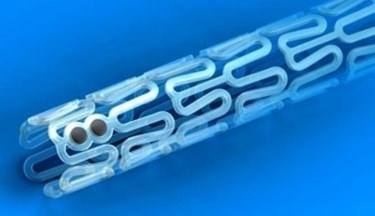Abbott's Fully Resorbable Heart Stent Performs Well In Trials

In a trial comparing one-year outcomes of Abbott’s Absorb stent against the company’s market-leading Xience, Abbott reported no statistically significant difference between the stent that dissolves over time and the metallic, drug-eluting stent that has been permanently placed. Abbott’s Absorb currently is on the market in over 100 countries, and Abbott believes these most recent findings will help Absorb achieve regulatory approval in the U.S. and China.
The Absorb stent is a first-of-its kind technology poised to revolutionize cardiovascular therapeutics. After initial implantation, the stent functions like a drug-eluting metallic stent, holding open a blocked artery to restore free flow of blood and releasing a drug to counteract potentially dangerous side effects. Though the technology is life-saving, over time a permanent stent restricts vessel movement and limits future treatment options. Conversely, a bioresorbable stent dissolves, leaving behind a restored vessel that is free to flex and move as the patient’s heart demands.
In an editorial published last year in the Journal of the American College of Cardiology (JACC), experts called bioresorbable stents an “immature technology in need of a mature application.” While stating that the advantages of an implant that dissolves after its work is done are “intuitive,” the writers claimed that more data was required to demonstrate long-term effectiveness equal to tried-and-true, drug-eluting metallic stents.
In their most recent clinical trial with Absorb, ABSORB III, researchers demonstrated results which show Absorb’s strong performance in comparison to a traditional option over one year. Trial results were published in The New England Journal of Medicine (NEJM). Over 13,000 patients were evaluated in the U.S. and Australia, and primary and secondary endpoints for both the Absorb and Xience stents were within a 4.5 percentage point noninferiority margin for risk difference.
“The primary end point of target-lesion failure at one year occurred in 7.8 percent of patients in the Absorb group and 6.1 percent of patients in the Xience group,” stated researchers in the NEJM. Target-lesion failure is a term that includes heart disease-related deaths, heart attacks, and repeat procedures involving the treated vessel. A study comparing Absorb to Xience in 480 patients in mainland China demonstrated a similar comparison and was published in JACC.
“Results of the Absorb III pivotal trial show that Absorb is comparable to the best-in-class metallic stent. However, because Absorb leaves nothing behind it may provide significant long-term benefits, such as a restored vessel in a natural state and renewed possibilities for people treated with Absorb,” said Charles Simonton, CMO and Divisional VP of Medical Affairs at Abbott, in a press release.
While these results may be enough to garner regulatory approval in the lucrative U.S. and China markets, some experts are troubled by increased risk associated with the bioresorbable stents —particularly the nearly doubled likelihood of stent thrombosis (formation of blood clots near the stent) — and urge caution as these technologies are adopted for clinical use.
Robert Byrne, an interventional cardiologist at Deutches Herzzentrum (German Heart Institute) in Munich, published an editorial alongside the NEJM study.
In it, Byrne wrote, “Although the concept of self-degrading stents is intuitively attractive, promise alone is not enough to make us unconditionally embrace this technology. For the moment, the trends towards higher event rates with the Absorb scaffold and the additional challenges associated with implantation must be considered.”
